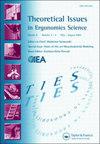Weight watchers: NASA-TLX weights revisited
IF 1.4
Q4 ERGONOMICS
引用次数: 12
Abstract
Abstract National Aeronautics and Space Administration Task Load Index (NASA-TLX) is a popular method to evaluate mental workload. NASA-TLX assesses mental workload across six load dimensions. When the dimensions are not assumed to be approximately equally important, they are weighted by conducting a pairwise comparison for every dimension pair, followed by the normalisation of weights reflecting the importance of the dimensions. This original NASA-TLX weighting method creates some challenges that are difficult to identify when the weights are being assigned. First, the original NASA-TLX weighting does not allow directly expressing two or more dimensions as equally important. Second, if pairwise comparisons are conducted consistently, there exists only one possible importance order for the dimensions. Third, with consistently conducted pairwise comparisons, a weight of 0.33 is artificially forced on the most important dimension. Swing and Analytic Hierarchy Process weighting methods for eliciting the weights of the dimensions are proposed as a solution to these challenges. The advantages of applying these methods in NASA-TLX are introduced theoretically and demonstrated empirically using data from virtual air combat simulations. The objective of this paper is to help scholars and practitioners to use NASA-TLX in mental workload assessments such that the discussed weighting issues are avoided.体重观察者:重新审视NASA-TLX重量
摘要美国国家航空航天局任务负荷指数(NASA-TLX)是一种常用的评估心理负荷的方法。NASA-TLX评估了六个负荷维度的心理工作量。当假设维度不近似同等重要时,通过对每个维度对进行成对比较来对其进行加权,然后对反映维度重要性的权重进行归一化。这种最初的NASA-TLX加权方法带来了一些挑战,这些挑战很难在分配权重时识别。首先,最初的NASA-TLX加权不允许将两个或多个维度直接表示为同等重要。其次,如果一致地进行成对比较,则维度只存在一个可能的重要性顺序。第三,通过持续进行成对比较,在最重要的维度上人为地强制使用0.33的权重。针对这些挑战,提出了Swing和层次分析法加权方法来获取维度的权重。从理论上介绍了在NASA-TLX中应用这些方法的优势,并使用虚拟空战模拟的数据进行了实证验证。本文的目的是帮助学者和从业者在心理工作量评估中使用NASA-TLX,从而避免所讨论的权重问题。
本文章由计算机程序翻译,如有差异,请以英文原文为准。
求助全文
约1分钟内获得全文
求助全文

 求助内容:
求助内容: 应助结果提醒方式:
应助结果提醒方式:


